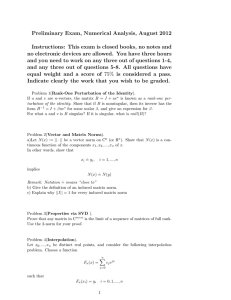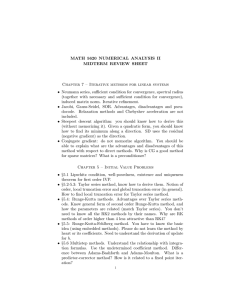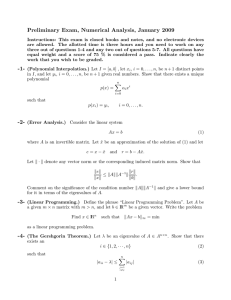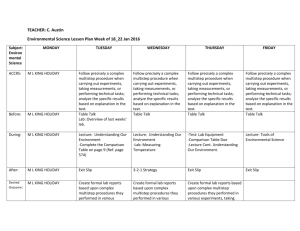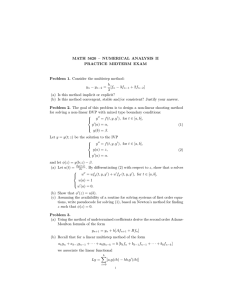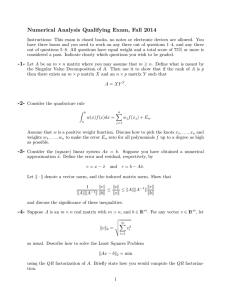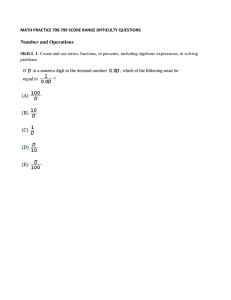Introduction to Simulation - Lecture 14 Multistep Methods II Jacob White
advertisement
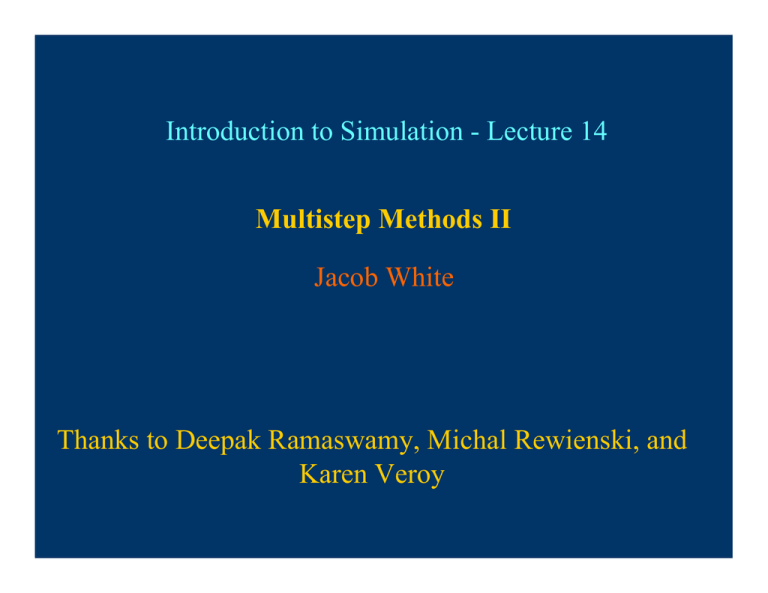
Introduction to Simulation - Lecture 14 Multistep Methods II Jacob White Thanks to Deepak Ramaswamy, Michal Rewienski, and Karen Veroy Outline Small Timestep issues for Multistep Methods Reminder about LTE minimization A nonconverging example Stability + Consistency implies convergence Investigate Large Timestep Issues Absolute Stability for two time-scale examples. Oscillators. Basic Equations Multistep Methods General Notation Nonlinear Differential Equation: k-Step Multistep Approach: xˆ xˆ l −k l −2 ˆx l −1 xˆ l d x(t ) = f ( x(t ), u (t )) dt k k j =0 j =0 ( l− j l− j ˆ ˆ α x = ∆ t β f x , u ( tl − j ) ∑ j ∑ j Multistep coefficients Solution at discrete points tl − k tl −3 tl − 2 tl −1 tl Time discretization ) Simplified Problem for Analysis Multistep Methods Scalar ODE: d v ( t ) = λ v(t ), v ( 0 ) = v0 dt k k Scalar Multistep formula: λ ∈^ l− j l− j ˆ ˆ α v = ∆ t β λ v ∑ j ∑ j j =0 j =0 Must Consider ALL λ ∈ ^ Im ( λ ) Decaying Solutions O s c i l l a t i o n s Growing Solutions Re ( λ ) Multistep Methods Convergence Analysis Convergence Definition Definition: A multistep method for solving initial value problems on [0,T] is said to be convergent if given any initial condition max ⎡ T ⎤ l∈⎢0, ⎥ ⎣ ∆t ⎦ ˆvl − v ( l ∆t ) → 0 as ∆t → 0 ˆv l computed with ∆t ∆t l vˆ computed with 2 vexact Multistep Methods Convergence Analysis Two Conditions for Convergence 1) Local Condition: “One step” errors are small (consistency) Typically verified using Taylor Series 2) Global Condition: The single step errors do not grow too quickly (stability) Multi-step (k > 1) methods require careful analysis. Convergence Analysis Multistep Methods Global Error Equation k Multistep formula: Exact solution Almost satisfies Multistep Formula: ∑α j vˆ l− j j =0 k k − ∆t ∑ β j λ vˆl − j = 0 j =0 k d l α − ∆ β = v t t v t e ( ∑ ∑ j ( l− j ) j l− j ) dt j =0 j =0 Global Error: E l ≡ v ( tl ) − vˆ l Local Truncation Error (LTE) Difference equation relates LTE to Global error l l −1 l −k l α − λ ∆ t β E + α − λ ∆ t β E + " + α − λ ∆ t β E = e ( 0 ( 1 ( k 0) 1) k) Making LTE Small Multistep Methods Exactness Constraints k k d l α − ∆ β = v t t v t e ( ∑ Local Truncation Error: ∑ j ( l − j ) j l− j ) dt j =0 j =0 Can't be from d v (t ) = λv (t ) dt LTE d p −1 If v ( t ) = t ⇒ v ( t ) = pt dt p k j ) ∆t ) ( k − ∑ α ( v (t ) j =0 j k− j p k p −1 − ∆t ∑ β j p ( ( k − j ) ∆ t ) =e j =0 d v ( tk − j ) dt k Multistep Methods Making LTE Small Exactness Constraint k=2 Example k ⎛ k p p −1 ⎞ Exactness Constraints: ⎜ ∑ α j ( k − j ) − ∑ β j p ( k − j ) ⎟ = 0 j =0 ⎝ j =0 ⎠ For k=2, yields a 5x6 system of equations for Coefficients p=0 p=1 p=2 p=3 p=4 ⎡1 ⎢2 ⎢ ⎢4 ⎢ ⎢8 ⎢⎣16 1 1 1 1 1 1 0 0 −1 0 −4 0 −12 0 −32 0 −1 −2 −3 −4 ⎡α 0 ⎤ 0 ⎤ ⎢ ⎥ ⎡0⎤ α1 ⎥ ⎢ ⎥ ⎥ ⎢ −1⎥ 0 ⎢α 2 ⎥ ⎢ ⎥ 0 ⎥ ⎢ ⎥ = ⎢0⎥ ⎥ ⎢ β0 ⎥ ⎢ ⎥ 0⎥ 0⎥ ⎢ ⎢ β1 ⎥ 0 ⎥⎦ ⎢ ⎥ ⎢⎣0 ⎥⎦ ⎢⎣ β 2 ⎥⎦ Note ∑αi = 0 Always Multistep Methods Making LTE Small Exactness Constraint k=2 example, generating methods First introduce a normalization, for example α 0 = 1 ⎡1 ⎢1 ⎢ ⎢1 ⎢ ⎢1 ⎢⎣1 0 0 ⎤ ⎡α1 ⎤ ⎡ −1 ⎤ −1 −1⎥⎥ ⎢⎢α 2 ⎥⎥ ⎢⎢ −2 ⎥⎥ 0 −4 −2 0 ⎥ ⎢ β 0 ⎥ = ⎢ −4 ⎥ ⎥⎢ ⎥ ⎢ ⎥ 0 −12 −3 0 ⎥ ⎢ β1 ⎥ ⎢ −8 ⎥ 0 −32 −4 0 ⎥⎦ ⎢⎣ β 2 ⎥⎦ ⎢⎣ −16 ⎥⎦ 1 0 0 −1 Solve for the 2-step method with lowest LTE α 0 = 1, α1 = 0, α 2 = −1, β 0 = 1/ 3, β1 = 4 / 3, β 2 = 1/ 3 Satisfies all five exactness constraints LTE = C ( ∆t ) 5 Solve for the 2-step explicit method with lowest LTE α 0 = 1, α1 = 4, α 2 = −5, β 0 = 0, β1 = 4, β 2 = 2 Can only satisfy four exactness constraints LTE = C ( ∆t ) 4 Making LTE Small Multistep Methods LTE Plots for the FE, Trap, and “Best” Explicit (BESTE). 0 10 d v (t ) = v (t ) d FE -5 L 10 T E Trap -10 10 Beste Best Explicit Method has highest one-step accurate -15 10 -4 10 -3 10 Timestep -2 10 -1 10 0 10 Making LTE Small Multistep Methods Global Error for the FE, Trap, and “Best” Explicit (BESTE). 0 10 M d a -2 d v (t ) = v (t ) 10 x E -4 r 10 r -6 10 o r t ∈ [0,1] FE Where’s BESTE? Trap -8 10 -4 10 -3 10 -2 10 Timestep -1 10 0 10 Multistep Methods Global Error for the FE, Trap, and “Best” Explicit (BESTE). worrysome 200 M 10 a x 100 E 10 r r 0 10 o r 10 Making LTE Small Best Explicit Method has lowest one-step error but global errror increases as timestep decreases d v (t ) = v (t ) d Beste FE Trap -100 10 -4 10 -3 10 Timestep -2 10 -1 10 0 Multistep Methods Stability of the method Difference Equation Why did the “best” 2-step explicit method fail to Converge? Multistep Method Difference Equation l l −1 l −k l α − λ ∆ t β E + α − λ ∆ t β E + " + α − λ ∆ t β E = e ( 0 ( 1 ( k 0) 1) k) v ( l ∆t ) − vˆ l LTE Global Error We made the LTE so small, how come the Global error is so large? Multistep Methods Stability of the method Stability Definition Multistep Method Difference Equation l l −1 l −k l α − λ ∆ t β E + α − λ ∆ t β E + " + α − λ ∆ t β E = e ( 0 ( 1 ( k 0) 1) k) Definition: A multistep method is stable if as ∆t → 0 T l l max ⎡ T ⎤ E ≤ C (T ) max ⎡ T ⎤ e N ∆t l∈⎢0, ⎥ l∈⎢0, ⎥ t ∆ ⎣ ⎦ ⎣ ∆t ⎦ interval dependent Global Error is bounded by a Stability means: constant times the sum of the LTE’s Convolution Sum Aside on difference Equations Root Relation Given a kth order difference eqn with zero initial conditions a0 x + " + ak x l l −k −1 = u , x = 0, " , x l l x x can be related to the input u by = Q M q −1 Root multiplicity m q =1 m=0 k −1 l− j j h u ∑ j =0 l Roots of a0 z + a1 z k l convolution sum h = ∑ ∑ γ q ,m ( l ) ( ς q ) l −k + " + ak = 0 =0 Aside on difference Equations Convolution Sum Bounding Terms Q M q −1 l ⎛ l− j m l j ⎞ x = ∑ ∑ ⎜ ∑ γ q ,m ( l − j ) ( ς q ) u ⎟ q =1 m =0 ⎝ j =0 ⎠ Rq ,m If ς q <1, then Rq ,m ≤ C max j u j Independent of l If ς q < (1+ε ) , then Rq ,0 ≤ C e εl ε Bounds distinct Roots max j u j Multistep Methods Stability of the method Stability Theorem Theorem: A multistep method is stable if and only if Roots of α 0 z k + α1 z k −1 + " + α k = 0 either: 1. Have magnitude less than one 2. Have magnitude equal to one and are distinct Multistep Methods Stability of the method Stability Theorem “Proof” Given the Multistep Method Difference Equation (α 0 − λ∆t β 0 ) E l + (α1 − λ∆t β1 ) E l −1 + " + (α k − λ∆t β k ) E l −k = el If, as ∆t → 0, roots of (α 0 − λ∆t β 0 ) z l + " + (α k − λ∆t β k ) = 0 • less than one in magnitude or • are distinct and bounded by 1 + κ∆t , κ > 0 Then from the aside on difference equations κ l ∆t κT e C e T l l l max ⎡ T ⎤ E ≤ C max ⎡ T ⎤ e ≤ max ⎡ T ⎤ e l∈⎢0, ⎥ l∈⎢0, ⎥ l∈⎢0, ⎥ t T t ∆ ∆ N t t ∆ ∆ ⎣ ⎦ ⎣ ⎦ ⎣ ∆t ⎦ C (T ) Multistep Methods Stability of the method Stability Theorem Picture roots of k ∑α j =0 j z k− j =0 -1 roots of Im As ∆t → 0, roots move inward to match α polynomial 1 k Re k− j α − λ ∆ t β z = 0 for a nonzero ∆t ∑( j j) j =0 Stability of the method Multistep Methods The BESTE Method Best explicit 2-step method α 0 = 1, α1 = 4, α 2 = −5, β 0 = 0, β1 = 4, β 2 = 2 Im roots of z + 4 z − 5 = 0 2 -5 -1 1 Method is Wildly unstable! Re Multistep Methods Stability of the method Dahlquist’s First Stability Barrier For a stable, explicit k-step multistep method, the maximum number of exactness constraints that can be satisfied is less than or equal to k (note there are 2k-1 coefficients). For implicit methods, the number of constraints that can be satisfied is either k+2 if k is even or k+1 if k is odd. Convergence Analysis Multistep Methods Conditions for convergence, stability and consistency 1) Local Condition: One step errors are small (consistency) Exactness Constraints up to p0 (p0 must be > 0) ⇒ max ⎡ T ⎤ l∈⎢0, ⎥ ⎣ ∆t ⎦ e ≤ C1 ( ∆t ) l p0 +1 for ∆t < ∆t0 2) Global Condition: One step errors grow slowly (stability) roots of k k− j Inside the unit circle or on the α z = 0 ∑ j unit circle and distinct j =0 T ⇒ max ⎡ T ⎤ E ≤ C2 max ⎡ T ⎤ el l∈⎢0, ⎥ l∈⎢0, ⎥ t ∆ ∆ t ⎣ ⎦ ⎣ ∆t ⎦ p0 l Convergence Result: max ⎡ T ⎤ E ≤ CT ( ∆t ) l l∈⎢ 0, ⎥ ⎣ ∆t ⎦ Multistep Methods Large timestep stability Two time-constant circuit small ∆t Backward-Euler Computed Solution Circuit Example d x(t ) = Ax(t ) dt eig ( A) = −2.1, −0.1 large ∆t With Backward-Euler it is easy to use small timesteps for the fast dynamics and then switch to large timesteps for the slow decay Large Timestep Stability Multistep Methods FE on two time-constant circuit? Forward-Euler Computed Solution The Forward-Euler is accurate for small timesteps, but goes unstable when the timestep is enlarged Large Timestep Stability Multistep Methods Scalar ODE: FE, BE and Trap on the scalar ode problem d v ( t ) = λ v(t ), v ( 0 ) = v0 dt λ ∈^ l +1 l l l Forward-Euler: vˆ = vˆ + ∆t λ vˆ = (1 + ∆t λ ) vˆ If 1 + ∆t λ > 1 the solution grows even if λ <0 1 l +1 l l +1 l +1 Backward-Euler: vˆ = vˆ + ∆t λ vˆ ⇒ vˆ = (1 − ∆tλ ) vˆl 1 If < 1 the solution decays even if λ > 0 1 − ∆t λ Trap Rule: vˆ l +1 = vˆ + 0.5∆t λ ( vˆ l l +1 + vˆ ) ⇒ vˆ l l +1 1 + 0.5∆t λ ) l ( = vˆ (1 − 0.5∆tλ ) Large Timestep Stability Multistep Methods Forward Euler z = (1 + ∆t λ ) -1 Im ( λ ) ODE stability region Im(z) Difference Eqn Stability region FE large timestep region of absolute stability 1 Re(z) −2 ∆t Region of Absolute Stability Re ( λ ) Large Timestep Stability Multistep Methods FE large timestep stability, circuit example Circuit example with ∆t = 0.1, λ = −2.1, − 0.1 Im ( λ ) ODE stability region Im(z) -1 Difference Eqn Stability region 1 Re(z) −2 ∆t Region of Absolute Stability Re ( λ ) Large Timestep Stability Multistep Methods FE large timestep stability, circuit example Circuit example with ∆t=1.0, λ = −2.1, − 0.1 Im ( λ ) Unstable Difference Equation -1 ODE stability region Im(z) Difference Eqn Stability region 1 Re(z) −2 ∆t Region of Absolute Stability Re ( λ ) Large Timestep Stability Multistep Methods Backward Euler BE large timestep region of absolute stability z = (1 − ∆t λ ) −1 Im(z) -1 Difference Eqn Stability region 1 Re(z) Region of Absolute Stability Im ( λ ) Large Timestep Stability Multistep Methods BE large timestep stability, circuit example Circuit example with ∆t = 0.1, λ = −2.1, − 0.1 Im ( λ ) Im(z) -1 Difference Eqn Stability region 1 Re(z) Region of Absolute Stability Large Timestep Stability Multistep Methods BE large timestep stability, circuit example Circuit example with ∆t =1.0, λ = −2.1, − 0.1 Im ( λ ) Stable Difference Equation Im(z) -1 Difference Eqn Stability region 1 Re(z) Region of Absolute Stability Large Timestep Stability Multistep Methods Stability Definitions Region of Absolute Stability for ak Multistep method: Values of λ∆t where roots of ∑ (α j − λ∆t β j ) z k − j = 0 are inside the unit circle. j =0 A-stable: A method is A-stable if its region of absolute stability includes the entire left-half of the complex plane Dahlquist’s second Stability barrier: There are no A-stable multistep methods of convergence order greater than 2, and the trap rule is the most accurate. Multistep methods 4 2 Numerical Experiments Oscillating Strut and Mass ∆t = 0.1 Forward-Euler 0 -2 -4 -6 Trap rule 0 5 10 Backward-Euler 15 20 25 30 Why does FE result grow, BE result decay and the Trap rule preserve oscillations Large Timestep Stability Multistep Methods Forward Euler FE large timestep oscillator example z = (1 + ∆t λ ) Im ( λ ) ODE stability region Im(z) oscillating unstable -1 Difference Eqn Stability region 1 Re(z) −2 ∆t Region of Absolute Stability Re ( λ ) Large Timestep Stability Multistep Methods Backward Euler BE large timestep oscillator example z = (1 − ∆t λ ) −1 Im ( λ ) Im(z) decaying -1 Difference Eqn Stability region 1 oscillating Re(z) Region of Absolute Stability Large Timestep Stability Multistep Methods Trap large timestep oscillator example 1 + 0.5∆t λ ) ( Trap Rule z = (1 − 0.5∆t λ ) Im ( λ ) Im(z) oscillating oscillating -1 Difference Eqn Stability region 1 Re(z) Region of Absolute Stability Multistep Methods Large Timestep Issues Two Time-Constant Stable problem (Circuit) FE: stability, not accuracy, limited timestep size. BE was A-stable, any timestep could be used. Trap Rule most accurate A-stable m-step method Oscillator Problem Forward-Euler generated an unstable difference equation regardless of timestep size. Backward-Euler generated a stable (decaying) difference equation regardless of timestep size. Trapezoidal rule mapped the imaginary axis Summary Small Timestep issues for Multistep Methods Local truncation error and Exactness. Difference equation stability. Stability + Consistency implies convergence. Investigate Large Timestep Issues Absolute Stability for two time-scale examples. Oscillators. Didn’t talk about Runge-Kutta schemes, higher order A-stable methods.
